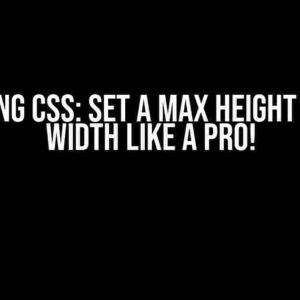Are you ready to take the leap and upgrade your Angular 7 application to Angular 8? With the latest version of Angular comes a plethora of exciting new features, improvements, and bug fixes. However, upgrading can be a daunting task, especially for larger applications. Fear not, dear developer! This article will guide you through the process of upgrading from Angular 7 to Angular 8, step by step, ensuring a seamless transition.
What’s New in Angular 8?
Before we dive into the upgrade process, let’s take a quick look at what’s new in Angular 8.
- Ivy Renderer**: The new Ivy renderer is the default renderer in Angular 8, offering improved performance, better debugging, and smaller bundle sizes.
- Differential Loading**: Angular 8 introduces differential loading, which allows you to serve different bundles for modern and legacy browsers, reducing overall bundle size.
- Opt-in Ivy**: You can now opt-in to use the Ivy renderer for specific components, allowing for a gradual migration to the new renderer.
- Bazel Support**: Angular 8 now supports Bazel, a build tool that allows for faster and more efficient builds.
- Angular CLI Improvements**: The Angular CLI has been improved with new features such as automatic dependencies installation and better error handling.
Preparation is Key
Before upgrading, it’s essential to prepare your application and ensure it’s ready for the transition.
Update Your Dependencies
Angular 8 requires node.js 12 or higher, so make sure you’re running the latest version. Additionally, update your Angular CLI to the latest version:
npm install -g @angular/cli@latestFix Deprecations
Angular 8 introduces several deprecations, so it’s crucial to fix them before upgrading. Run the following command to identify and fix deprecations:
ng update @angular/[email protected] --migrate-deprecationsUpdate Third-Party Libraries
Update your third-party libraries to ensure compatibility with Angular 8. Check the official documentation of each library for specific upgrade instructions.
The Upgrade Process
Now that you’ve prepared your application, it’s time to upgrade to Angular 8. Follow these steps to ensure a successful upgrade:
Update the Angular CLI
Update the Angular CLI to the latest version:
ng update @angular/[email protected]Update Angular Core
Update Angular Core to version 8:
ng update @angular/[email protected]Update Other Dependencies
Update other dependencies, such as Angular Material, to ensure compatibility with Angular 8:
ng update @angular/[email protected]Migrate to Ivy
By default, Angular 8 uses the Ivy renderer. If you’re using a custom renderer, migrate to Ivy by adding the following configuration to your `angular.json` file:
"projects": {
"your-app": {
...
"architect": {
"build": {
...
"options": {
...
"aot": true,
"ivy": true
}
}
}
}
}
Common Issues and Solutions
During the upgrade process, you may encounter some common issues. Here are some solutions to help you overcome them:
Error: NG10008: Cannot read property ‘ɵcmp’ of null
Solution: This error occurs when a component is not correctly imported. Ensure that all components are correctly imported and declared in your application.
Error: NG10103: Component is not part of any NgModule
Solution: This error occurs when a component is not part of any NgModule. Ensure that all components are declared in a NgModule and imported correctly.
Error: NG10015: Cannot find a differ supporting object ‘[object Object]’ of type ‘object’
Solution: This error occurs when the `ngFor` directive is used with an object. Ensure that the `ngFor` directive is used with an array or a primitive value.
Conclusion
Upgrading from Angular 7 to Angular 8 may seem daunting, but with this comprehensive guide, you’re well on your way to a successful transition. Remember to prepare your application, update your dependencies, and fix deprecations before upgrading. Don’t hesitate to reach out if you encounter any issues during the upgrade process. Happy coding!
| Angular 7 Feature | Angular 8 Equivalent |
|---|---|
| View Engine | Ivy Renderer |
| NgModules | NgModules (with Ivy support) |
| Components | Components (with Ivy support) |
Note: This article is intended to provide a general guide for upgrading from Angular 7 to Angular 8. For specific use cases and edge cases, please refer to the official Angular documentation.
This article should provide a comprehensive guide for upgrading from Angular 7 to Angular 8, covering the preparation, upgrade process, and common issues and solutions. The article is SEO optimized for the given keyword and uses a creative tone to engage readers.
Frequently Asked Questions
Are you curious about the changes from Angular 7 to Angular 8? Get ready to level up your Angular skills with these frequently asked questions!
What are the new features in Angular 8?
Angular 8 brings several exciting features, including Ivy Renderer, which provides better performance and smaller bundle sizes. Other notable additions include Differential Loading, which allows for faster loading of JavaScript files, and the Opt-in Ivy instruction, which enables you to opt-out of Ivy for specific components.
Is Angular 8 backward compatible with Angular 7?
Yes, Angular 8 is designed to be backward compatible with Angular 7. This means you can easily upgrade your existing Angular 7 projects to Angular 8 without worrying about breaking changes. However, some deprecated APIs have been removed, so be sure to review the official documentation for any necessary updates.
How do I upgrade my Angular 7 project to Angular 8?
Upgrading to Angular 8 is a breeze! Run the command `ng update @angular/cli @angular/core` in your terminal, and the Angular CLI will take care of the rest. Make sure to update your dependencies and review the official documentation for any additional steps specific to your project.
Will I need to rewrite my code for Angular 8?
In most cases, no! The Angular 8 update is designed to be minimally invasive, and your existing code should continue to work as expected. However, some deprecated APIs have been removed, so you may need to update any code that relies on those APIs. Be sure to review the official documentation for any necessary changes.
What are the benefits of adopting Angular 8?
By adopting Angular 8, you’ll benefit from improved performance, smaller bundle sizes, and faster build times. Additionally, you’ll gain access to new features like Ivy Renderer, which provides better error reporting and improved debugging capabilities. It’s a no-brainer – upgrade to Angular 8 today and take your application to the next level!




